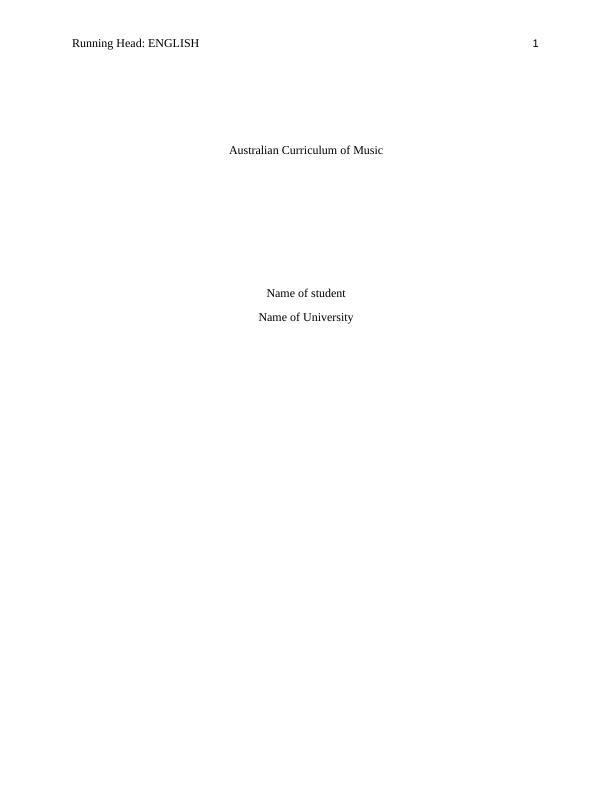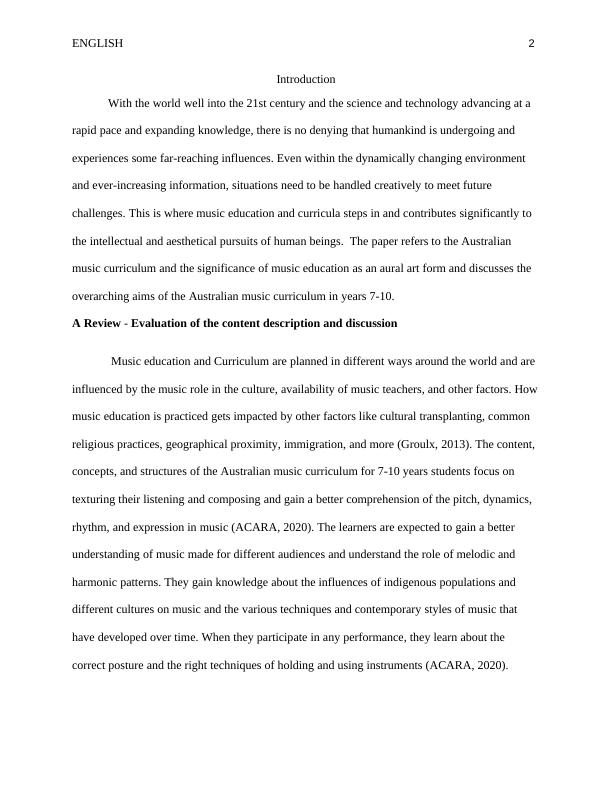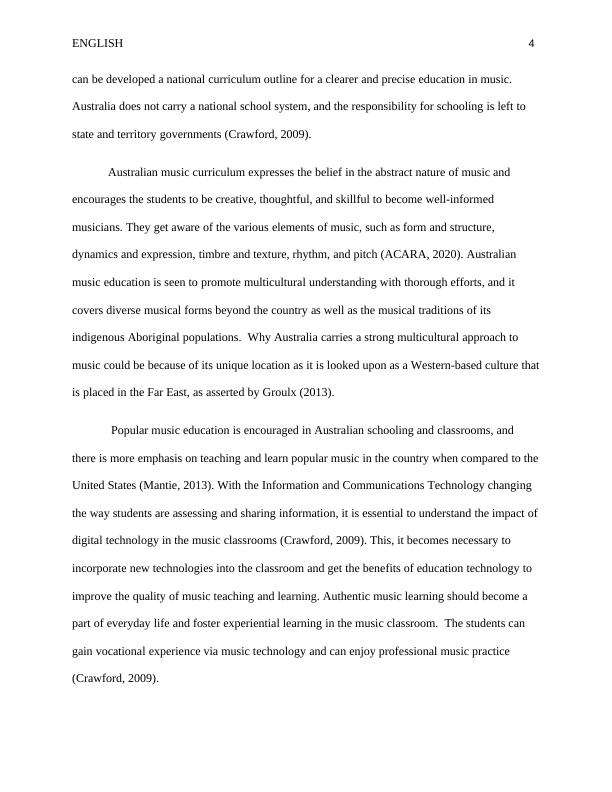Australian Curriculum of Music | Assignment
Added on 2022-08-20
12 Pages3371 Words34 Views
Running Head: ENGLISH 1
Australian Curriculum of Music
Name of student
Name of University
Australian Curriculum of Music
Name of student
Name of University

ENGLISH 2
Introduction
With the world well into the 21st century and the science and technology advancing at a
rapid pace and expanding knowledge, there is no denying that humankind is undergoing and
experiences some far-reaching influences. Even within the dynamically changing environment
and ever-increasing information, situations need to be handled creatively to meet future
challenges. This is where music education and curricula steps in and contributes significantly to
the intellectual and aesthetical pursuits of human beings. The paper refers to the Australian
music curriculum and the significance of music education as an aural art form and discusses the
overarching aims of the Australian music curriculum in years 7-10.
A Review - Evaluation of the content description and discussion
Music education and Curriculum are planned in different ways around the world and are
influenced by the music role in the culture, availability of music teachers, and other factors. How
music education is practiced gets impacted by other factors like cultural transplanting, common
religious practices, geographical proximity, immigration, and more (Groulx, 2013). The content,
concepts, and structures of the Australian music curriculum for 7-10 years students focus on
texturing their listening and composing and gain a better comprehension of the pitch, dynamics,
rhythm, and expression in music (ACARA, 2020). The learners are expected to gain a better
understanding of music made for different audiences and understand the role of melodic and
harmonic patterns. They gain knowledge about the influences of indigenous populations and
different cultures on music and the various techniques and contemporary styles of music that
have developed over time. When they participate in any performance, they learn about the
correct posture and the right techniques of holding and using instruments (ACARA, 2020).
Introduction
With the world well into the 21st century and the science and technology advancing at a
rapid pace and expanding knowledge, there is no denying that humankind is undergoing and
experiences some far-reaching influences. Even within the dynamically changing environment
and ever-increasing information, situations need to be handled creatively to meet future
challenges. This is where music education and curricula steps in and contributes significantly to
the intellectual and aesthetical pursuits of human beings. The paper refers to the Australian
music curriculum and the significance of music education as an aural art form and discusses the
overarching aims of the Australian music curriculum in years 7-10.
A Review - Evaluation of the content description and discussion
Music education and Curriculum are planned in different ways around the world and are
influenced by the music role in the culture, availability of music teachers, and other factors. How
music education is practiced gets impacted by other factors like cultural transplanting, common
religious practices, geographical proximity, immigration, and more (Groulx, 2013). The content,
concepts, and structures of the Australian music curriculum for 7-10 years students focus on
texturing their listening and composing and gain a better comprehension of the pitch, dynamics,
rhythm, and expression in music (ACARA, 2020). The learners are expected to gain a better
understanding of music made for different audiences and understand the role of melodic and
harmonic patterns. They gain knowledge about the influences of indigenous populations and
different cultures on music and the various techniques and contemporary styles of music that
have developed over time. When they participate in any performance, they learn about the
correct posture and the right techniques of holding and using instruments (ACARA, 2020).

ENGLISH 3
As they advance and progress to higher age and experiences, they continue to develop
their aural skills and enhance their understanding of more complex rhythms and pitch and learn
between different instruments and vocal techniques (ACARA, 2020). They engage with more
diverse music from a range of cultures and times and explore various traditional and
contemporary styles of music. They add to their understanding of previous bands and musicians
with more diverse music.
According to Krause & Davidson (2018), musical success is defined by fine musical
ability and instrumental mastery. Musical engagement is known to benefits the students in other
curriculum performance and their socio-emotional well-being. According to the Kodály
philosophy of music education, music belongs to everyone, and it is the right of every individual
to learn the basic elements of music. The early preparation of children with music and melody
works as nourishment as it helps to develop concentration and the ability to condition oneself
(Micheal & Tacka, 2015). The basic components of the lesson plans for music education in the
classroom should cover the knowledge of musical concepts and preparation of a melodic
element. The children should feel confident about the performance of musical skills, develop the
singing ability as they acquire music literacy skills. The students should gain an understanding of
basic melodic building blocks as they get creative with new musical elements (Micheal & Tacka,
2015).
The Australian music education systems share a similar philosophy with the British
educational practice and are used to raise the cultural level of the uneducated. The vocal music
was introduced into some Australian schools in the nineteenth century. The Australian Society
for Music Education (ASME) was first set up in 1967 (Groulx, 2013). It is difficult to generalize
the education in Australia as the decision-making practices can vary from state to state. There
As they advance and progress to higher age and experiences, they continue to develop
their aural skills and enhance their understanding of more complex rhythms and pitch and learn
between different instruments and vocal techniques (ACARA, 2020). They engage with more
diverse music from a range of cultures and times and explore various traditional and
contemporary styles of music. They add to their understanding of previous bands and musicians
with more diverse music.
According to Krause & Davidson (2018), musical success is defined by fine musical
ability and instrumental mastery. Musical engagement is known to benefits the students in other
curriculum performance and their socio-emotional well-being. According to the Kodály
philosophy of music education, music belongs to everyone, and it is the right of every individual
to learn the basic elements of music. The early preparation of children with music and melody
works as nourishment as it helps to develop concentration and the ability to condition oneself
(Micheal & Tacka, 2015). The basic components of the lesson plans for music education in the
classroom should cover the knowledge of musical concepts and preparation of a melodic
element. The children should feel confident about the performance of musical skills, develop the
singing ability as they acquire music literacy skills. The students should gain an understanding of
basic melodic building blocks as they get creative with new musical elements (Micheal & Tacka,
2015).
The Australian music education systems share a similar philosophy with the British
educational practice and are used to raise the cultural level of the uneducated. The vocal music
was introduced into some Australian schools in the nineteenth century. The Australian Society
for Music Education (ASME) was first set up in 1967 (Groulx, 2013). It is difficult to generalize
the education in Australia as the decision-making practices can vary from state to state. There

ENGLISH 4
can be developed a national curriculum outline for a clearer and precise education in music.
Australia does not carry a national school system, and the responsibility for schooling is left to
state and territory governments (Crawford, 2009).
Australian music curriculum expresses the belief in the abstract nature of music and
encourages the students to be creative, thoughtful, and skillful to become well-informed
musicians. They get aware of the various elements of music, such as form and structure,
dynamics and expression, timbre and texture, rhythm, and pitch (ACARA, 2020). Australian
music education is seen to promote multicultural understanding with thorough efforts, and it
covers diverse musical forms beyond the country as well as the musical traditions of its
indigenous Aboriginal populations. Why Australia carries a strong multicultural approach to
music could be because of its unique location as it is looked upon as a Western-based culture that
is placed in the Far East, as asserted by Groulx (2013).
Popular music education is encouraged in Australian schooling and classrooms, and
there is more emphasis on teaching and learn popular music in the country when compared to the
United States (Mantie, 2013). With the Information and Communications Technology changing
the way students are assessing and sharing information, it is essential to understand the impact of
digital technology in the music classrooms (Crawford, 2009). This, it becomes necessary to
incorporate new technologies into the classroom and get the benefits of education technology to
improve the quality of music teaching and learning. Authentic music learning should become a
part of everyday life and foster experiential learning in the music classroom. The students can
gain vocational experience via music technology and can enjoy professional music practice
(Crawford, 2009).
can be developed a national curriculum outline for a clearer and precise education in music.
Australia does not carry a national school system, and the responsibility for schooling is left to
state and territory governments (Crawford, 2009).
Australian music curriculum expresses the belief in the abstract nature of music and
encourages the students to be creative, thoughtful, and skillful to become well-informed
musicians. They get aware of the various elements of music, such as form and structure,
dynamics and expression, timbre and texture, rhythm, and pitch (ACARA, 2020). Australian
music education is seen to promote multicultural understanding with thorough efforts, and it
covers diverse musical forms beyond the country as well as the musical traditions of its
indigenous Aboriginal populations. Why Australia carries a strong multicultural approach to
music could be because of its unique location as it is looked upon as a Western-based culture that
is placed in the Far East, as asserted by Groulx (2013).
Popular music education is encouraged in Australian schooling and classrooms, and
there is more emphasis on teaching and learn popular music in the country when compared to the
United States (Mantie, 2013). With the Information and Communications Technology changing
the way students are assessing and sharing information, it is essential to understand the impact of
digital technology in the music classrooms (Crawford, 2009). This, it becomes necessary to
incorporate new technologies into the classroom and get the benefits of education technology to
improve the quality of music teaching and learning. Authentic music learning should become a
part of everyday life and foster experiential learning in the music classroom. The students can
gain vocational experience via music technology and can enjoy professional music practice
(Crawford, 2009).

End of preview
Want to access all the pages? Upload your documents or become a member.
Related Documents
Importance of Music, Movement and Drama in Early Childhood Educationlg...
|10
|2607
|313
Music Arts in Childhoodlg...
|5
|1145
|87
Teaching Humanities and Social Science in Australialg...
|10
|3202
|486
Exploring and Contesting the Curriculumlg...
|6
|1752
|71
Reflection on Role of Familylg...
|5
|1135
|20
Working with Families and Communities in Early Childhood Education Serviceslg...
|10
|2734
|384
